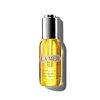What's inside
What's inside
 Key Ingredients
Key Ingredients

 Benefits
Benefits

 Concerns
Concerns

 Ingredients Side-by-side
Ingredients Side-by-side

Limnanthes Alba Seed Oil
Skin ConditioningDimethicone
EmollientCaprylic/Capric Triglyceride
MaskingWater
Skin ConditioningTrisiloxane
Skin ConditioningPrunus Amygdalus Dulcis Oil
Skin ConditioningSimmondsia Chinensis Seed Oil
EmollientPolydecene
Skin ConditioningHydrogenated Polydecene
EmollientButylene Glycol
HumectantPropanediol
SolventGlycerin
HumectantAlgae Extract
EmollientBrassica Campestris Seed Oil
Skin ConditioningHelianthus Annuus Seed Oil
EmollientSesamum Indicum Seed Oil
EmollientEucalyptus Globulus Leaf Oil
PerfumingCamelina Sativa Seed Oil
Skin ConditioningOxycoccus Palustris Seed Oil
AntioxidantOlea Europaea Fruit Oil
MaskingHippophae Rhamnoides Oil
EmollientMedicago Sativa Seed Powder
Skin ConditioningHelianthus Annuus Seedcake
AbrasivePrunus Amygdalus Dulcis Seed Meal
AbrasiveSodium Gluconate
Skin ConditioningCopper Gluconate
Skin ConditioningCalcium Gluconate
HumectantMagnesium Gluconate
Skin ConditioningZinc Gluconate
Skin ConditioningTocopheryl Succinate
AntioxidantNiacin
SmoothingSesamum Indicum Seed Powder
Skin ConditioningLaminaria Ochroleuca Extract
Skin ConditioningLaminaria Saccharina Extract
Skin ProtectingHydrolyzed Algin
Sea Salt
AbrasiveChlorella Vulgaris Extract
Skin ConditioningSalicornia Herbacea Extract
Skin ConditioningSigesbeckia Orientalis Extract
Skin ConditioningLaminaria Digitata Extract
Skin ProtectingRosmarinus Officinalis Leaf Extract
AntimicrobialMagnolia Officinalis Bark Extract
AntimicrobialYeast Extract
Skin ConditioningCrithmum Maritimum Extract
Skin ConditioningCommiphora Mukul Resin Extract
Skin ConditioningCitrus Aurantifolia Peel Extract
CleansingMolasses Extract
Skin ConditioningSucrose
HumectantAcetyl Hexapeptide-8
HumectantAcetyl Glucosamine
Skin ConditioningCaffeine
Skin ConditioningTocopheryl Acetate
AntioxidantPhenyl Trimethicone
Skin ConditioningSodium Chloride
MaskingTetrahexyldecyl Ascorbate
AntioxidantAlcohol Denat.
AntimicrobialParfum
MaskingHexyl Cinnamal
PerfumingLinalool
PerfumingAmyl Cinnamal
PerfumingGeraniol
PerfumingLimonene
PerfumingCitral
PerfumingBenzyl Benzoate
AntimicrobialCoumarin
PerfumingCitronellol
PerfumingBHT
AntioxidantPhenoxyethanol
PreservativeCI 19140
Cosmetic ColorantCI 15985
Cosmetic ColorantLimnanthes Alba Seed Oil, Dimethicone, Caprylic/Capric Triglyceride, Water, Trisiloxane, Prunus Amygdalus Dulcis Oil, Simmondsia Chinensis Seed Oil, Polydecene, Hydrogenated Polydecene, Butylene Glycol, Propanediol, Glycerin, Algae Extract, Brassica Campestris Seed Oil, Helianthus Annuus Seed Oil, Sesamum Indicum Seed Oil, Eucalyptus Globulus Leaf Oil, Camelina Sativa Seed Oil, Oxycoccus Palustris Seed Oil, Olea Europaea Fruit Oil, Hippophae Rhamnoides Oil, Medicago Sativa Seed Powder, Helianthus Annuus Seedcake, Prunus Amygdalus Dulcis Seed Meal, Sodium Gluconate, Copper Gluconate, Calcium Gluconate, Magnesium Gluconate, Zinc Gluconate, Tocopheryl Succinate, Niacin, Sesamum Indicum Seed Powder, Laminaria Ochroleuca Extract, Laminaria Saccharina Extract, Hydrolyzed Algin, Sea Salt, Chlorella Vulgaris Extract, Salicornia Herbacea Extract, Sigesbeckia Orientalis Extract, Laminaria Digitata Extract, Rosmarinus Officinalis Leaf Extract, Magnolia Officinalis Bark Extract, Yeast Extract, Crithmum Maritimum Extract, Commiphora Mukul Resin Extract, Citrus Aurantifolia Peel Extract, Molasses Extract, Sucrose, Acetyl Hexapeptide-8, Acetyl Glucosamine, Caffeine, Tocopheryl Acetate, Phenyl Trimethicone, Sodium Chloride, Tetrahexyldecyl Ascorbate, Alcohol Denat., Parfum, Hexyl Cinnamal, Linalool, Amyl Cinnamal, Geraniol, Limonene, Citral, Benzyl Benzoate, Coumarin, Citronellol, BHT, Phenoxyethanol, CI 19140, CI 15985
Ingredients Explained
These ingredients are found in both products.
Ingredients higher up in an ingredient list are typically present in a larger amount.
BHT is a synthetic antioxidant and preservative.
As an antioxidant, it helps your body fight off free-radicals. Free-radicals are molecules that may damage your skin cells.
As a preservative, it is used to stabilize products and prevent them from degrading. Specifically, BHT prevents degradation from oxidation.
The concerns related to BHT come from oral studies; this ingredient is currently allowed for use by both the FDA and EU.
However, it was recently restricted for use in the UK as of April 2024.
Learn more about BHTCitral is a fragrance and used to add a lemon-like scent to products. It is both naturally found in plants and created synthetically. In plants, it is commonly occurring in lemon myrtle, lemongrass, lemon tea-tree, lemon verbena, and other citruses.
The EU mandates Citral be listed separately as a fragrance. It is a known allergen and may cause contact dermatitis. Citral can also used as a masking ingredient.
The term 'fragrance' is not regulated in many countries. In many cases, it is up to the brand to define this term. For instance, many brands choose to label themselves as "fragrance-free" because they are not using synthetic fragrances. However, their products may still contain ingredients such as essential oils that are considered a fragrance.
The term 'citral' is a collective term for two geometric isomers: geranial/Citral A and neral/Citral B.
Learn more about CitralCoumarins are a group of substances found naturally in plants. There are over 1300 types of coumarins identified. It has a natural vanilla scent.
Coumarin is an identified EU known allergy, meaning it may cause an allergic reaction when applied to the skin.
In many countries, coumarin is banned as a food additive. However, it can be found in soaps, tobacco products, and some alcohol drinks.
Plants use coumarins as a chemical defense. Some plants that have coumarins include lavender, tonka beans, and yellow clovers.
Learn more about CoumarinGeraniol is used to add fragrance/parfum to a product. It is the main component of citronellol. It is a monoterpenoid and an alcohol.
Monoterpenes are naturally found in many parts of different plants.
Geraniol can be found in many essential oils including Rose Oil and Citronella Oil. The scent of Geraniol is often described as "rose-like". Many foods also contain Geraniol for fruit flavoring.
Geraniol can irritate the skin when exposed to air. However, irritation depends on the ability of geraniol to penetrate into the skin. In general, geraniol is not able to penetrate skin easily.
Geraniol is colorless and has low water-solubility. However, it is soluble in common organic solvents.
Like citronellol, it is a natural insect repellent.
2,6-Octadien-1-ol, 3,7-dimethyl-, (2E)-
Learn more about GeraniolHippophae Rhamnoides Oil also known as seabuckthorn oil. This oil is usually extracted from the fruit pulp or seeds.
Seabuckthorn is rich in phytosterols, carotenoids, Vitamins A, C, and E. This gives it strong antioxidant properties that can help soothe and protect your skin from oxidative damage.
This oil is rich in fatty acids, including: two types of linoleic acid (~30-34%), oleic acid (17%), and palmiteic acid (35%). Note these numbers are averages, and different parts of the plant will vary.
Palmitoleic acid has been shown to help soothe inflammation and promote wound healing. It is also naturally found in the fat of our skin.
Overall, seabuckthorn oil is great for nourishing, hydrating, and soothing skin. While it shows UV protecting properties, it should not replace sunscreen.
Due to the rich fatty acid content, this ingredient may not be Malassezia folliculitis, or fungal acne, safe.
Seabuckthorn berries are little orange fruits. This plant is native to Asia.
Learn more about Hippophae Rhamnoides OilLimonene is a fragrance that adds scent and taste to a formulation.
It's found in the peel oil of citrus fruits and other plants such as lavender and eucalyptus. The scent of limonene is generally described as "sweet citrus".
Limonene acts as an antioxidant, meaning it helps neutralize free radicals.
When exposed to air, oxidized limonene may sensitize the skin. Because of this, limonene is often avoided by people with sensitive skin.
The term 'fragrance' is not regulated in many countries. In many cases, it is up to the brand to define this term. For instance, many brands choose to label themselves as "fragrance-free" because they are not using synthetic fragrances. However, their products may still contain ingredients such as essential oils that are considered a fragrance.
Learn more about LimoneneLinalool is a fragrance and helps add scent to products. It's derived from common plants such as cinnamon, mint, citrus, and lavender.
Like Limonene, this ingredient oxidizes when exposed to air. Oxidized linalool can cause allergies and skin sensitivity.
This ingredient has a scent that is floral, spicy tropical, and citrus-like.
Learn more about LinaloolParfum is a catch-all term for an ingredient or more that is used to give a scent to products.
Also called "fragrance", this ingredient can be a blend of hundreds of chemicals or plant oils. This means every product with "fragrance" or "parfum" in the ingredients list is a different mixture.
For instance, Habanolide is a proprietary trade name for a specific aroma chemical. When used as a fragrance ingredient in cosmetics, most aroma chemicals fall under the broad labeling category of “FRAGRANCE” or “PARFUM” according to EU and US regulations.
The term 'parfum' or 'fragrance' is not regulated in many countries. In many cases, it is up to the brand to define this term.
For instance, many brands choose to label themselves as "fragrance-free" because they are not using synthetic fragrances. However, their products may still contain ingredients such as essential oils that are considered a fragrance by INCI standards.
One example is Calendula flower extract. Calendula is an essential oil that still imparts a scent or 'fragrance'.
Depending on the blend, the ingredients in the mixture can cause allergies and sensitivities on the skin. Some ingredients that are known EU allergens include linalool and citronellol.
Parfum can also be used to mask or cover an unpleasant scent.
The bottom line is: not all fragrances/parfum/ingredients are created equally. If you are worried about fragrances, we recommend taking a closer look at an ingredient. And of course, we always recommend speaking with a professional.
Learn more about ParfumPrunus Amygdalus Dulcis Oil comes from the sweet almond, a tree native to Iran. This oil has no fragrance and is non-volatile.
Almonds contain healthy fats, vitamins, and minerals. It is a rich source of Vitamin E, a great antioxidant and skin conditioning ingredient. Sweet almond oil contains fatty acids such as linolenic acid and triglycerides.
The content of sweet almond oil makes it a great emollient; it can help soften and hydrate your skin. Emollients create a barrier over your skin to trap moisture in. Sweet almond oil has antioxidant properties.
Those with an almond allergy should be careful of this ingredient and speak with a professional about using it in your skincare.
This ingredient may not be fungal-acne safe.
Learn more about Prunus Amygdalus Dulcis OilRosmarinus Officinalis Leaf Extract comes from rosemary. Rosemary is native to the Mediterranean.
While Rosmarinus Officinalis Leaf Oil can be volatile due to its fragrant properties, the fragrance components are usually removed in the leaf extract.
Rosemary Leaf Extract contains many antioxidants such as rosmarinic acid and caffeic acid. Rosemarinic acid, a compound found in rosemary leaf, has been found to help soothe skin conditions such as eczema and acne.
Learn more about Rosmarinus Officinalis Leaf ExtractTocopheryl Acetate is AKA Vitamin E. It is an antioxidant and protects your skin from free radicals. Free radicals damage the skin by breaking down collagen.
One study found using Tocopheryl Acetate with Vitamin C decreased the number of sunburned cells.
Tocopheryl Acetate is commonly found in both skincare and dietary supplements.
Learn more about Tocopheryl Acetate